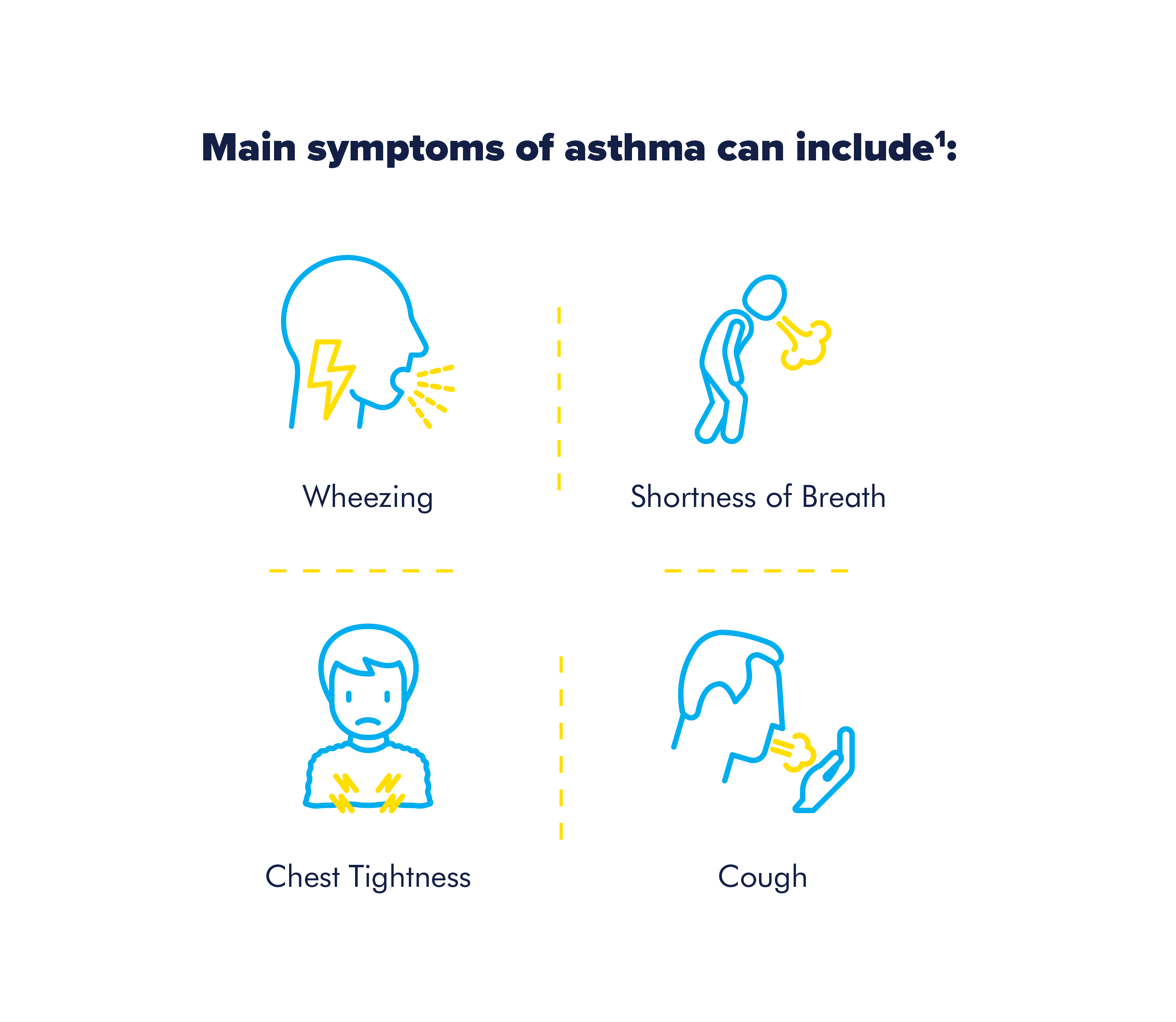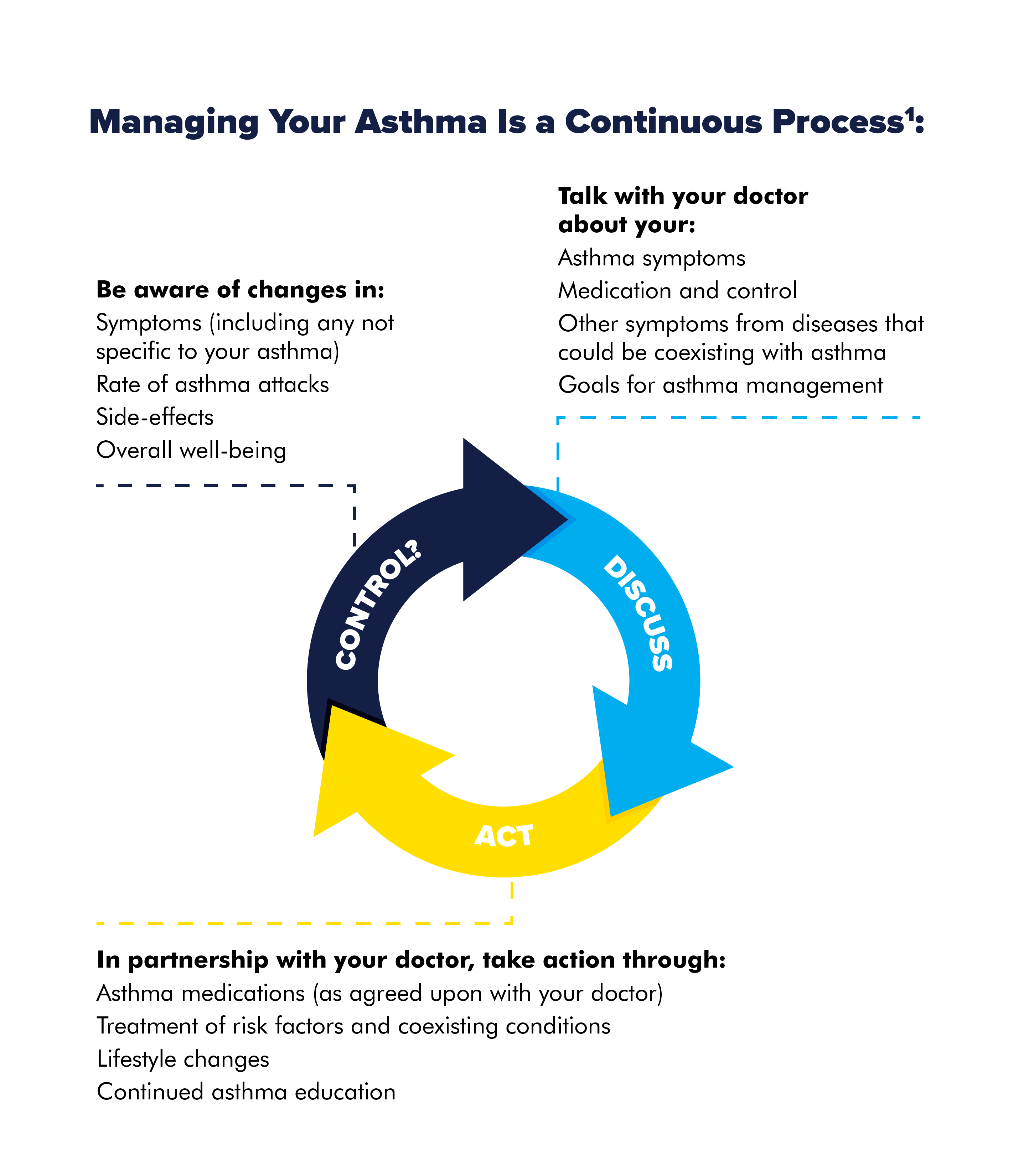

UNDERSTANDING SEVERE ASTHMA
An asthma diagnosis is the first step to receiving appropriate care. We discuss the process and why the journey doesn’t stop there.
Living with asthma is different for every person, with a range of symptoms, variable triggers and differing levels of symptom control. For many, the journey begins when they experience breathing difficulties.
Stage 1: Recognizing the symptoms and making an appointment with your doctor
The main symptoms of asthma include wheezing, shortness of breath, chest tightness and cough.1 If you experience any of these symptoms, book either an in-person or telehealth/online appointment with your primary care physician or an asthma specialist, to discuss your symptoms. This is particularly important if you have experienced them over a period of time. It is essential to get a diagnosis, whether it is to confirm asthma or to rule it out, to ensure that you receive the most appropriate care.


During your first appointment, a doctor is likely to ask you to describe the symptoms you’re experiencing, along with any patterns you may have noticed. Get the most out of your appointment by writing this information down beforehand so as to not forget anything. Patterns to note include the types of symptoms you experience, if they are worse at a certain time of day, if they vary over time and in intensity, or if you have noticed any specific triggers, such as exercise, allergens or changes in weather.1
Stage 2: Getting an initial asthma diagnosis
If your doctor feels that your symptoms suggest asthma, he or she may carry out a few tests to confirm a diagnosis, including:2,3
- Peak expiratory flow, often known as peak flow, is a test that indicates how open your airways are. It involves taking a deep breath and blowing as hard as possible into a handheld plastic tube called a peak flow meter.
- Spirometry is a test that measures how fast you can breathe out and how much air you can hold in your lungs. A mouthpiece is attached to a tube and a small machine called a spirometer.
- A FeNO (fractional concentration of exhaled nitric oxide) test indicates inflammation in the airways. FeNO is measured by blowing slowly and steadily into a portable device, which measures a gas called nitric oxide in exhaled air.1,4
A diagnosis of asthma is an important step, but it’s just the start of a journey towards achieving better asthma control. If your doctor feels that it is necessary, they may recommend further tests with a specialist, such as a pulmonologist (also known as a respirologist) or an allergist. These tests could include blood tests assessing levels of a specific immune cell called an eosinophil or an allergic marker called IgE.5,6 The aim of these tests is to help generate a picture of the underlying root causes that may be driving your asthma, such as a specific type of inflammation called type 2 inflammation that is present in around 50-70% of people with asthma.1,7,8
Stage 3: Managing your asthma
Asthma is a chronic disease – meaning that it persists over a long time – and as such, achieving asthma control needs to be a long-term effort. When we talk about asthma control, we mean the extent to which symptoms are reduced or eliminated through disease management.1
Achieving asthma control requires:
- A continuous process of talking with your doctor about the type, frequency, duration and severity of your asthma symptoms
- Taking action in partnership with your doctor to address them, including through a written asthma management plan
- Regularly reassessing your disease activity and the impact asthma has on your quality of life
It is important to note that control can mean different things to different people. Whether you think your asthma is controlled or not, if your symptoms keep coming back, and even worse keep you from doing the things you want to do, it is vital to have an honest conversation with your doctor and take action together to get better control of your symptoms, and improve your life.


Managing asthma can be complicated; there may be several reasons why a person continues to experience asthma symptoms after starting treatment.1 It’s not a failure if your symptoms continue to have an impact on your life – it just means that you and your doctor need to reassess your asthma management plan to see what improvements can be made.
If you continue to experience symptoms or asthma attacks, despite the use of multiple controller medicines, it could be a sign of having severe asthma, which is harder to treat. Asthma severity is assessed by looking back at the level of treatment required to control symptoms.1 Asthma severity is not constant and can improve and worsen over time. That is why it is important to continuously asses your level of control and raise any changes with a doctor so that together you can act. If your symptoms are more difficult to control, then consider asking to see a specialist who may be able to help further.1
Achieving better asthma control is possible for everyone with asthma, but it represents a continuous process and is one that is important to monitor, even when it feels like control has been achieved.
References:
- 1. GINA 2020 Global Initiative for Asthma (GINA). Global Strategy for Asthma Management and Prevention. 2020. Available at: https://ginasthma.org/gina-reports/. Accessed: August 2020.
- 2. Asthma UK. Tests to diagnose and monitor asthma. Available at: https://www.asthma.org.uk/advice/diagnosis/tests/. Accessed: August 2020.
- 3. NHS. Diagnosis, Asthma. Available at: https://www.nhs.uk/conditions/asthma/diagnosis/. Accessed: August 2020.
- 4. AAAAI. WHAT IS A FENO TEST? Available at: https://www.aaaai.org/conditions-and-treatments/library/asthma-library/feno-test. Accessed: August 2020.
- 5. WebMD. How Do I Know if I Have Eosinophilic Asthma? Available at: https://www.webmd.com/asthma/eosinophilic-asthma-diagnosis#2. Accessed August 2020.
- 6. Froidure, Antoine, et al. "Asthma phenotypes and IgE responses." European Respiratory Journal 47.1 (2016): 304-319.
- 7. Fahy JV. Type 2 inflammation in asthma — present in most, absent in many. Nat Rev lmmunol. 2015;15(1):57-65.
- 8. Peters MC, Mekonnen ZK, Yuan S, et al. Measure of gene expression in sputum cells can identify TH2-high and TH2-low subtypes of asthma. J Allergy Clin Immunol. 2014;133(2):388-394.
Date of Approval: September 2020 | MAT-GLB-2001884



Join the Next Breath Challenge: It’s Time to Prioritize Asthma Control & Demand Access to Specialized Care
The Next Breath Editorial Team
5/4/2021 12:00:00 AM
The Next Breath Challenge encourages you to gently blow out a digital candle, creating a powerful symbol for prioritizing better asthma control. Take action now.

3 Things To Know About Frequent Oral Corticosteroid Use
The Next Breath Editorial Team
3/22/2021 12:00:00 AM
Learn more about oral corticosteroids, including their use as an asthma medicine and when to talk with a doctor about ways to achieve better asthma control.

Join the Next Breath Challenge: It’s Time to Prioritize Asthma Control & Demand Access to Specialized Care
The Next Breath Editorial Team
5/4/2021 12:00:00 AM
The Next Breath Challenge encourages you to gently blow out a digital candle, creating a powerful symbol for prioritizing better asthma control. Take action now.

3 Things To Know About Frequent Oral Corticosteroid Use
The Next Breath Editorial Team
3/22/2021 12:00:00 AM
Learn more about oral corticosteroids, including their use as an asthma medicine and when to talk with a doctor about ways to achieve better asthma control.
Moving the future of asthma forward, together
Working together, we can bring more awareness to
severe asthma,
illuminate the latest
science and
empower people to take action
to strive for better asthma control.
Start using your next breath today
to inspire others to get informed and
check back
soon to find more ways to get involved.































